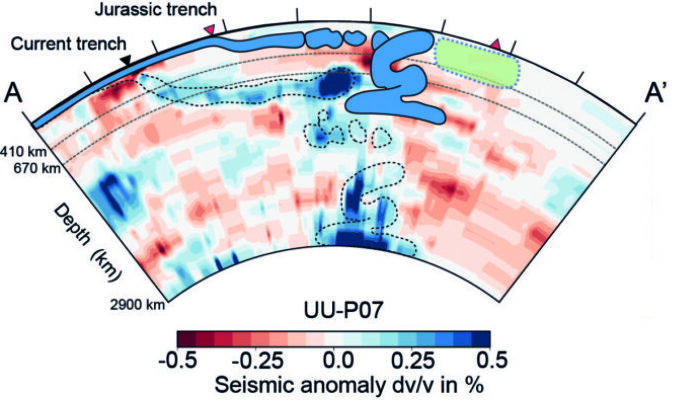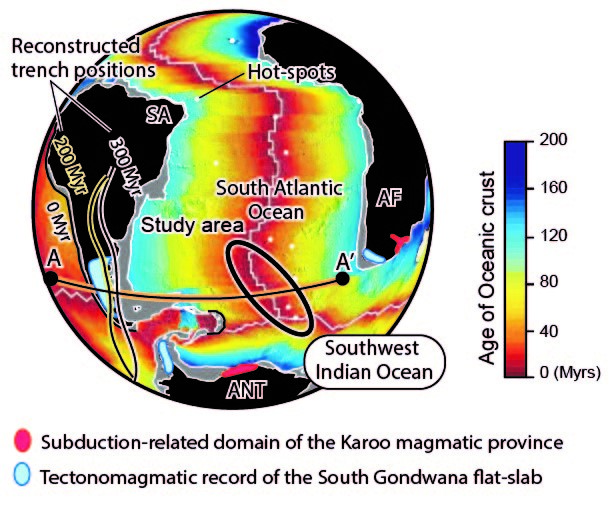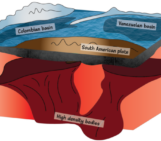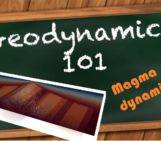
Today we are going to talk about ghosts. Not the kind of ghosts that chase you in your nightmares, like scary reviewer 2. This time, we will talk about how the mysterious geochemical signature of a ghost–arc, the one that you would expect to find under a volcanic arc of a subduction zone, ends up appearing in the geochemistry of a Mid-Ocean Ridge. Prof. Dr. Guido Gianni from the University of San Juan (Argentina) is a ghost-arc buster. He will share with us some clues on how to identify their geochemical signature and better understand their origins.
A ghost-arc geochemical signature in mid–ocean ridges?

Guido is a researcher at the University of San Juan and CONICET in Argentina. His research focuses on the study of convergent settings by inspecting tectonic, magmatic, sedimentary, and mantle records. You can contact him by email, Twitter or Researchgate.
Mid-ocean oceanic ridges (MORs) are enormous chains of submarine volcanoes made of basalts, reaching heights of approximately 2 km and extending thousands of kilometers. They form in areas where two tectonic plates separate, as is currently happening in the Atlantic Ocean. These ridge systems create the oceanic crust when the magma coming from the upper mantle cools down. The upper mantle, known for its low concentration of incompatible elements, is commonly referred to as the depleted magma source that typifies the majority of MORs. Just like in life, there are exceptions, and recent scientific studies have uncovered a captivating puzzle within the mantle beneath specific mid-ocean ridges. These areas show slight chemical indicators of being influenced by subduction, which is marked by a distinct geochemical fingerprint called “backarc basin basalt-like” or “ghost-arc” (which I personally find cooler!) encountered in some basalts and abbysal peridotites (Figure 1; e.g., Richter et al., 2020; Yang et al., 2021, Wang et al., 2023). These geochemical fingerprints can not be accounted for by the usual process of decompression melting at mid-ocean ridges. Instead, they indicate a melting history similar to what is currently observed beneath magmatic arc regions, where water content plays a key role. However, the mechanisms underlying the presence of residual subduction-modified mantle beneath MORs keeps escaping our grasp.
Figure 1: Geochemical diagrams of mid-ocean ridge (MOR) basalts from the Pacific, Southern South Atlantic, and Southwest Indian MORs. Total-alkali-silica diagram and trace-element systematics show the geochemical imprint of subduction arcs. (a) Na20+K20 vs. Si20, (b) Ce/Pb vs. Nb/Yb, (c) Ba/La vs. La/Yb. Figure modified from Gianni et al. (2023).
Hypotheses on the source of this ghost-arc signature
To unravel the mysteries surrounding ghost-arc signatures at MORs, two prominent hypotheses have emerged. The first hypothesis is mobilistic and proposes that a mantle source anomaly with the ghost-arc fingerprint is formed and then migrates to a MOR. The second hypothesis is fixist and suggests that the MOR migrated above and sampled a stagnant mantle source anomaly with the ghost-arc fingerprint. According to the mobilistic hypothesis, when a portion of the mantle melts beneath a magmatic arc, it incorporates fluids and sediments from the subducting plate. This melting process leaves behind a residue in the mantle with the ghost-arc geochemical fingerprint. Over time, the mantle is able to flow in a plastic-like manner (similar to play-doh when pressed), and can move away from subduction zones through a geological process called upper mantle convection. Eventually, it ends up beneath mid-ocean ridges (MORs) (Yang et al., 2021; Wang et al., 2023). In the fixist hypothesis, the upper mantle retains a geochemical memory of past subduction processes, where the mantle residues with ghost-arc geochemical fingerprints remain relatively stationary for long periods of time (Gao et al., 2016; Richter et al., 2020; van Hinsberger et al., 2020). In this context, the stagnant mantle anomalies can be sampled, for example, during MOR overriding, where the movement of tectonic plates brings the residual subduction-modified mantle into contact with the MOR system, causing it to melt.
The case of the ghost-arc geochemical anomaly of the South Atlantic and Southwest Indian Mid-Ocean Ridges
Our study explored the origins of a large zone that extends across the South Atlantic and Southwest Indian Mid-Ocean Ridges, displaying prominent ghost-arc geochemical fingerprints (Figure 2). This zone, that we refer to as the SASWIR subduction-modified mantle anomaly, has been previously associated with an ancient subduction zone along the active margin of Southwestern Gondwana that occurred 200 Ma (Le Roux et al., 2002). According to this hypothesis, a mobile mantle anomaly with ghost-arc signatures flowed away from the ancient active margin of southwest Gondwana towards the mid-ocean ridges and has been in this location since then. There is supporting evidence indicating the existence of a mantle anomaly beneath the study area for a significant period of time. This evidence is seen in the 183 million-year-old magmatic activity found in the Southern domain of the Karoo large igneous province. The magmatism, which was previously concentrated in a specific area but is now spread across South Africa and Antarctica, shows intriguing geochemical features related to subduction (Luttinen, 2018). These characteristics provide proof that there was a mantle anomaly with subduction influence beneath the region when the magmatism occurred.
Figure 2: The study area highlighting the zone along the South Atlantic and Southwest Indian mid-ocean ridges examined in our research. Figure modified from Gianni et al. (2023).
This mobilistic hypothesis proposing the origin of ghost-arc geochemical signatures in the study area has its limitations. For instance, it raises the following questions: why is this anomaly localized in a specific MOR area rather than being widespread, considering the extensive occurrence of subduction along the Gondwana margin? Are there remnants of an ancient subduction episode in the lower mantle that could explain our ghost-arc phenomenon?
Our approach and findings: hints on the presence of an ancient slab!
To gain insights into the origin of the SASWIR subduction-modified mantle anomaly, our study employed various analytical techniques. Firstly, we reconstructed the position of the subduction-related Southern Karoo magmatic province in the mantle reference frame. This analysis allowed us to evaluate the proposed link between the SASWIR subduction-modified mantle anomaly and the Southern Karoo region, as well as estimate the duration of the anomaly’s presence beneath the study area. Additionally, we examined global seismic tomography models, which provide blurry images of the mantle, to search for evidence of a potential fossil subducted plate that could explain the existence of the SASWIR subduction-modified mantle anomaly. Next, we integrated seismic tomography with plate kinematic reconstructions, which provide rough past locations of continents, to establish a connection between the ancient subducted plates, now deep within the mantle, and the reconstructed position of continental margins.
Our analysis has uncovered some fascinating findings: the SASWIR subduction-modified mantle source has remained relatively fixed within the mantle since the Jurassic. It formed near an ancient subducted tectonic plate called the Georgia Islands slab (Figure 3). Today, this slab is located at mantle depths ranging from approximately 1700 km to the base of the mantle at 2900 km, forming what we refer to as a “slab graveyard“. Interestingly, based on our reconstructions, during the Jurassic period, the Georgia Islands slab was positioned inland from the active margin of the Patagonian-Antarctic Peninsula. This is because, at that time, the slab was dipping horizontally over a large distance and plunged into the mantle beneath the continental interior, a process known as “flat subduction” (Navarrete et al., 2019; Gianni et al., 2019) (Figure 3). Therefore, our reconstructions provide evidence that the SASWIR subduction-modified mantle zone is likely an ancient feature that formed close to the Early Jurassic subduction of the Georgia Islands slab. This slab represents the furthest extent of the South Gondwana flat-slab before its disappearance. The alignment in paleogeography suggests a potential connection between the location of the SASWIR subduction-modified mantle zone and the Mesozoic flat slab process (Figure 3).
Figure 3. Seismic tomography cross-section displaying slab records in the upper and lower mantle, illustrating the correlation between the location of the SASWIR subduction-related mantle anomaly and the reconstructed position of the South Gondwana flat slab (220-185 Ma). See location of the A-A’ profile in Figure 1. Figure modified from Gianni et al. (2023).
Connecting a Supersized Flat Slab in South Gondwana to Ghost-Arc Geochemical Signatures in the SASWIR
We propose that the subduction-modified mantle beneath the Jurassic active margin of the Patagonian-Antarctic Peninsula, and possibly beneath neighboring suture zones, was transported inland together for a distance exceeding 2000 km during the Mesozoic South Gondwana flat subduction event (220-185 Ma) (Figure 3). After the flat slab disappeared, the mantle anomaly remained relatively stationary and was sampled by the Karoo mantle plume around 183 Ma, and later by the SASWIR. In this model, we introduce the concept of asthenospheric anomaly telescoping, which refers to the forced migration of subduction-influenced mantle, resulting in a relatively fixed sub-lithospheric mantle anomaly with a geochemical signature resembling ghost-arc characteristics in intraplate regions. This mechanism differs from the well-known mantle modifications typically associated with flat slabs that mostly affect the base of the continental plates. We suggest that asthenospheric anomaly telescoping has likely been occurring since the early stages of plate tectonics, contributing to the formation of variations in the upper mantle beneath continental interiors.
Implications for the geodynamics of the South American plate
In conclusion, the restricted movement of the SASWIR subduction-modified mantle anomaly in the study area over the past 185-180 million years suggests limited upper mantle flow. This finding has significant implications for current models of South American plate motion, which attribute a primary role to pronounced westward mantle flow since the Mesozoic. Thus, these findings challenge previous assumptions about mantle convection beneath the study area and highlight the complex nature of mantle dynamics beneath mid-ocean ridges. Overall, this investigation contributes to our broader understanding of geodynamics and the intricate relationship between subduction zone processes and mid-ocean ridge magmatism. Undoubtedly, further research in this field holds the promise of unveiling more mysteries, ultimately deepening our knowledge of Earth’s dynamic geology and the processes that shape both its interior and surface.
If you want to go deeper into our research, below is the full reference to our article:
Gianni, G. M., Likerman, J., Navarrete, C. R., Gianni, C. R., & Zlotnik, S. (2023). Ghost-arc geochemical anomaly at a spreading ridge caused by supersized flat subduction. Nature communications, 14(1), 2083. https://doi.org/10.1038/s41467-023-37799-w
References Gao, C., Dick, H. J., Liu, Y., & Zhou, H. (2016). Melt extraction and mantle source at a Southwest Indian Ridge Dragon Bone amagmatic segment on the Marion Rise. Lithos, 246, 48-60. https://doi.org/10.1016/j.lithos.2015.12.007 Gianni, G. M., Navarrete, C., & Spagnotto, S. (2019). Surface and mantle records reveal an ancient slab tear beneath Gondwana. Scientific reports, 9(1), 19774. https://doi.org/10.1038/s41598-019-56335-9 Luttinen, A. V. (2018). Bilateral geochemical asymmetry in the Karoo large igneous province. Scientific reports, 8(1), 5223.https://doi.org/10.1038/s41598-018-23661-3 Navarrete, C., Gianni, G., Encinas, A., Márquez, M., Kamerbeek, Y., Valle, M., & Folguera, A. (2019). Triassic to Middle Jurassic geodynamic evolution of southwestern Gondwana: From a large flat-slab to mantle plume suction in a rollback subduction setting. Earth-science reviews, 194, 125-159. https://doi.org/10.1016/j.earscirev.2019.05.002 Richter, M., Nebel, O., Maas, R., Mather, B., Nebel-Jacobsen, Y., Capitanio, F. A., ... & Cawood, P. A. (2020). An Early Cretaceous subduction-modified mantle underneath the ultraslow spreading Gakkel Ridge, Arctic Ocean. Science Advances, 6(44), eabb4340. https://doi.org/10.1126/sciadv.abb4340 van Hinsbergen, D. J., Spakman, W., de Boorder, H., Van Dongen, M., Jowitt, S. M., & Mason, P. R. (2020). Arc‐type magmatism due to continental‐edge plowing through ancient subduction‐enriched mantle. Geophysical Research Letters, 47(9), e2020GL087484. https://doi.org/10.1029/2020GL087484 Wang, J., Shang, X., Ma, Q., Chen, C., Liu, Y., & Li, C. (2023). Arc signatures in abyssal peridotites and its implications. Deep Sea Research Part I: Oceanographic Research Papers, 197, 104027. https://doi.org/10.1016/j.dsr.2023.104027 Yang, A. Y., Langmuir, C. H., Cai, Y., Michael, P., Goldstein, S. L., & Chen, Z. (2021). A subduction influence on ocean ridge basalts outside the Pacific subduction shield. Nature communications, 12(1), 4757. https://doi.org/10.1038/s41467-021-25027-2







